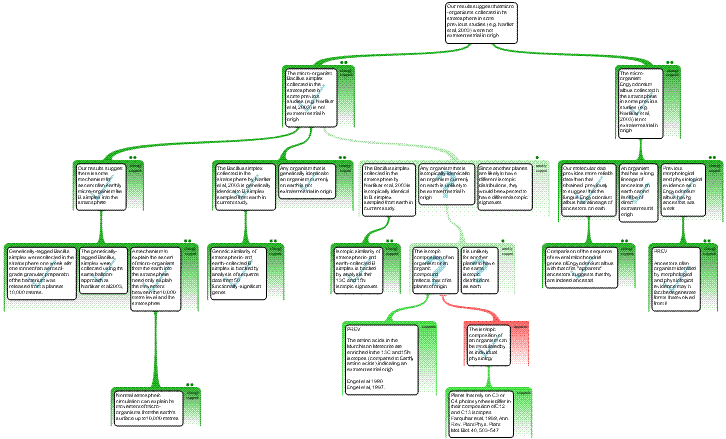The Science Of Scientific Writing Set F The Discussion Coherence: Speculative and Non-speculative Content Exercise 1 Maps for Discussions Exercise 2 Final Page .
OVERVIEW: The way to well-written science
PART I: Paragraphs and Sentences
SET A: Paragraphs: The Maps Behind Them
SET B: Paragraphs: Using Maps to Meet Readers' Expectations
SET C: Paragraphs with Something Extra: Points and Tails
SET D: The Generic Section: Expectations and Maps as Blueprints
SET E: Scientific Sections: The Methods and Results
SET F: Scientific Sections: The Discussion
SET G : Scientific Sections: The Introduction
SET H : Sentences
SET I : The Paper as a Whole
PART II: The Paper and its Sections
SET 1: Argument Parts
SET 2: Indicator Words
SET 4: Locating Arguments in Prose
SET 5: Rationale's Essay Planner
SET 6: Evidence in Arguments: Basis Boxes
Synthesis 1: Position-Early Paragraphs
Synthesis 2: Position-Final Paragraphs
Synthesis 3: Writing a Discussion I
Synthesis 4: Writing a Discussion II
Exercise 2
You are provided with a map for the argumentative part of a Discussion (this is not composed as a simple section map, it is fully-fleshed out). Drag the image below (using Rationale's inline browser) onto the Rationale workspace. An Introduction to the paper is provided at the bottom of this page. This map was composed using the Analysis mode of Rationale. It uses a double annotation system (depth of colour, number of dots) for assessments of argumentative strength, similar to what we have seen previously. The main difference between the Analysis and the simpler Reasoning mode of mapping, is that co-reasons (generally taking the form of assumptions) can be grouped together with the primary reason (which, in a group of reasons on a map, is the left-hand most reason).
Your tasks are to:
(1) Annotate branches of the map with stars to indicate your assessment of those branches' "potential importance" (this system is described on the previous page)
(2) Use MS Word to write up a two-part Discussion with a initial Framing Paragraph that provides a guide to BOTH parts.
(a) The first part will provide a text-version of the argument above. The sequence of the lines of evidence presented shoud at least in part be influenced by the argumentative strength and "potential importance" of the branches. Do not just cut and paste sentences from the map in writing up your text, this will result in a poorly written text.
The argumentative section should have multiple sub-sections, each with its own sub-heading. Each paragraph should have a framing and/or point sentence. These shoud be shown in bold.
(b) The second part will be speculative, and takes as its starting point that the reader is now convinced of the credbility of the main claim of the argument presented in the first part. You can discuss for example:
* The implications of the argument for our general understanding of the role of "cosmic rain" in seeding earth and other planets with life.
* The implications for future experiments
* Any other implications you can think of.
Introduction
Scientists have often pondered whether life of earth had an extraterrestrial origin, with most work focusing on life-forms or organic compounds that may have hitched a ride on a meteorite in the distant past. Another avenue of study has examined the possibility of organisms, or their spores, "raining down" upon earth as part of a living cosmic shower. This idea was tested during the late 90's and in the early part of the next decade by a team led by Narlikar in Hyderabad. They ran a series of tests where balloons were released into the stratosphere (above 25,000 metres) and then retrieved. Using stringent procedures to avoid contamination before release and upon retrieval, their collection equipment in the balloons yielded three types of micro-organisms, all known on earth: nanobacteria, Bacillus simplex, and the fungus Engyodontium albus (they referred to this by an earlier name). They argued that in the absence of any extraordinary meteorological events (which they had ruled out for the period leading up to the time of collection) it is not possible that the organisms entered the stratosphere from the earth, and that therefore they must have an extra-terrestrial origin.
No further work has yet followed up the results of Narlikar's team. If samples of the proposed extra-terrestrial organisms supplied the earth with their counterpart species many millions of years ago, then one would expect that in the intervening time, molecular and isotopic divergence between the extraterrestrial and current (terrestrial) populations would have occurred. At a more fundamental level, we also feel the previous authors have placed too much weight on findings that involve currently-occurring earth species, especially one with such a well-documented ancestry as Engyodontium albus. If Engyodontium albus is of extraterrestrial origin, then either (1) all of its apparent ancestors must be as well, which is highly unlikely or (2) the ancestors are only apparent as ancestors because of their simpler nature, but are in fact descendants of Engyodontium albus that have undergone evolutionary degeneration. Our concerns in this area make us interested in testing the assumption of the previous paper that there is no possibility that earth-sourced micro-organisms can make their way into the stratosphere.
In this study we explore the three lines of uncertainty noted above. We have examined the genetic and isotopic divergence of terrestrial and "extraterrestrial " B. simplex, using organisms collected on earth, and some of the original stratosphere-collected samples of Narlikar. Sequence data from 50 functionally-significant genes has been analysed. For both samples, we have also analysed the 13C and 15N isotopic signatures. For Engyodontium albus, we have examined the sequences of several mitochondrial genes of both itself and of a number of what have been assumed to be (on the basis of morphological and physiological characters) its ancestors. Finally, we have released genetically-tagged samples of B. simplex in the lower atmosphere, and tested (using the same balloon methodology as Narlikar) whether they appear in the stratosphere a week later.
......
